Operations: Car Movements
1. My Layout
My layout represents the Southern Central Railroad in 1888. The protype ran from Sayre in Pennsylvania to the southern shore of Lake Ontario in New York. I am modeling Auburn, New York, near the northern terminus. As the holder of significant dept for the SC, the Lehigh Valley Railroad controlled this line and eventually absorbed it to make the Southern Central part of the LV Auburn branch.
My drawing of the layout is not to scale, but shows all the main features, including visible car storage at northern and southern ends, and an interchange with the New York Central. As explained below, I do not have staging; I have small yards in which I store all rolling stock.
Rather than trains being staged at the beginning of an operating session, I have a handful of waybills for inbound and outbound movements of cars. An operator makes up a train from cars in the southern storage yard and runs to the northern terminus, another storage yard. Along the way, cars are dropped off and empties from an earlier run picked up. More cars might be picked up at this north storage yard, and the train is run to the south storage yard, making additional drop offs along the way. Once the train reaches this yard, it is broken down and cars switched onto appropriate storage tracks.
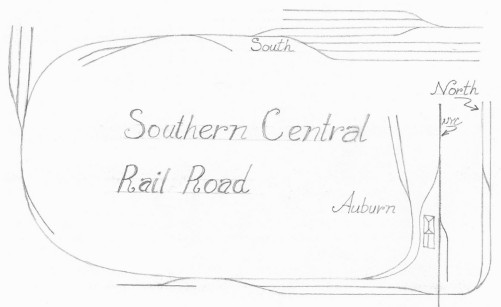
I started planning my current layout in 2002 and constructing it soon afterward, completing all benchwork, basic scenery, and some structures by the time of a regional NMRA convention in 2006. In the layout that preceded the current one, I used the familiar car card system described by so many authors in books and magazines. So, I had a stack of cards, one for each piece of rolling stock, and a waybill insert with four destinations stuck in each car card. I won't go into detail; most anybody interested in operations is familiar with the system through their reading or usage.
I actually had a very small fleet of railcars back then, and with between 70 and 80 cars, still do have a modest fleet. Filling out the car cards and waybills was not a big job. And, the system is easy to follow by visitors and to explain to newcomers.
Nevertheless, I was dissatisfied. It struck me and it has occurred to others that this approach has everything backwards; the availability of cars seems to drive the movement of rolling stock, not the need to move commodities. In addition, every car seems to be in motion in an operating session.
I started reading about car movement schemes in which the flow of commodities controlled the action. For instance, an industry would need a certain frequency of hoppers in with coal, and the empties would leave the layout. Furthermore, I thought it would be more realistic if trains were made up from an available stock of railcars, originating off the layout for foreign roads, and possibly on layout for home cars.
Meanwhile, I saw pictures of late 19th Century waybills in books on early rail lines, and knew they were very simple, including little more than the name of the railroad supplying the car, the car number, the origination point, the destination, and the commodity i.e. carriages, coal, steel plate, and so forth.
3. My Approach
I created a simple spreadsheet with columns for commodity, origination point, destination, and the railroad doing the shipping. An additional column is populated by a random number generator, so that every time I open the spreadsheet or do any kind of operation, each line has a different random number in this column. Sorting the rows in the spreadsheet by this number causes a different set of car movements to pop to the top rows. Here are the first few rows of this spreadsheet of inbound shipments:
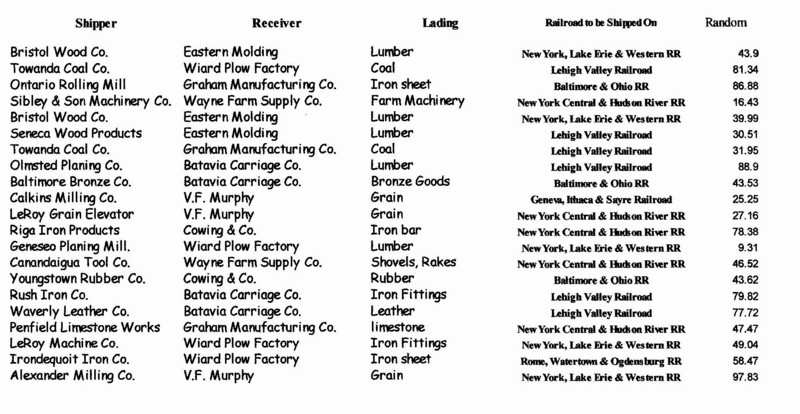
A second spreadsheet has six waybill templates for car movements onto the layout; each waybill has a place for the railroad at the top, a line for the originating business or industry name and location, a place for the destination, a place for the commodity, and a blank space for a car number. Information is copied automatically from each of the top six rows in the first spreadsheet to one of the tem-plate waybills. Since the top six shipments are determined by a random number, as long as I have lots of rows in the spreadsheet, the particular set of movements I get from session to session will always be different.
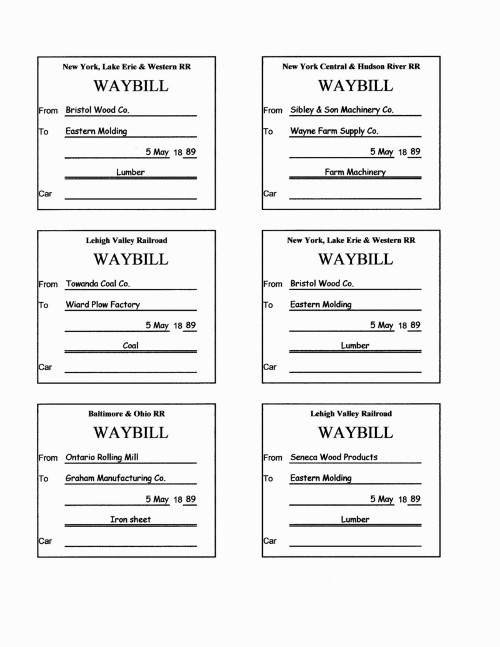
Notice how the waybills correspond to the top six rows of the spreadsheet.
A second pair of spreadsheets contain movements of cars off the layout i.e. outbound movements. The railroad is always the same, my home road, the Southern Central. In fact, I usually have to use Lehigh Valley cars; the SCRR owned very few cars. Here's the sheet of waybills . . .
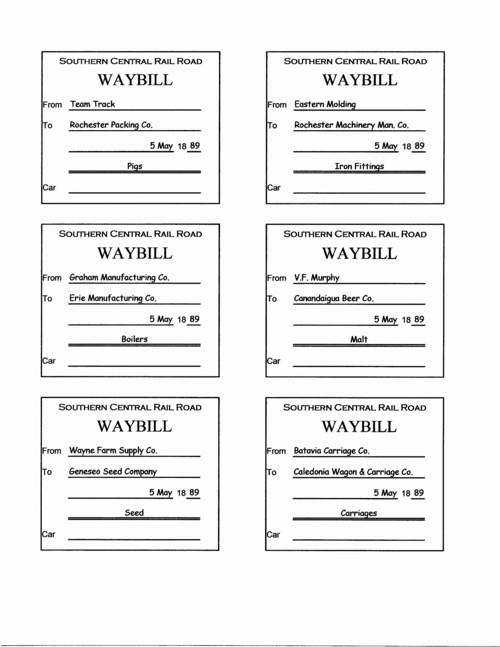
. . . and here's the corresponding spreadsheet of outbound shipments;, notice I don't need a column for railroads because it is always the same:
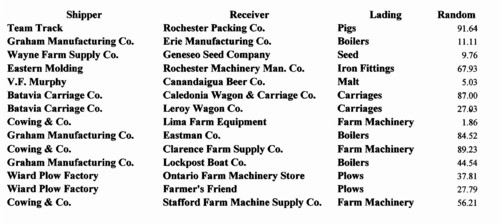
I could have included inbound and outbound movements in a single pair of spreadsheets, but following this approach, I can balance the movement of cars onto and off the layout.
I print out these two pages of waybills, cut them up, and select a few for each train. I usually run short trains of six to eight cars; it's a small layout.
4. Visible Storage
For easy retrieval, cars in the storage yards are grouped by railroad. Some modellers store cars in drawers or on shelves, but I store them out in the open. I don't like handling rolling stock, so I use yards to store cars. I like the look of those yards full of freight cars; "looks very railroady" a friend of mine says. Making up trains requires a lot of switching to pull appropriate cars, providing yet another job to do on my small layout. It may not be fully prototypical, but it's better than moving cars on and off by hand and sort of simulates the work in a large classification yard. When cars are returned to the yard, a switcher has to move each one to the track assigned to that car's railroad, representing the movement of that car towards its home.
The northern yard comprises only a couple of tracks because few railroads interchange with the Southern Central north of Auburn, the specific locality I am modeling. In this picture, the northern yard is at the extreme left and is in fact under construction. Auburn fills the center of the photo and includes a brick depot under construction, a two-track yard, and interchange with the New York Central.
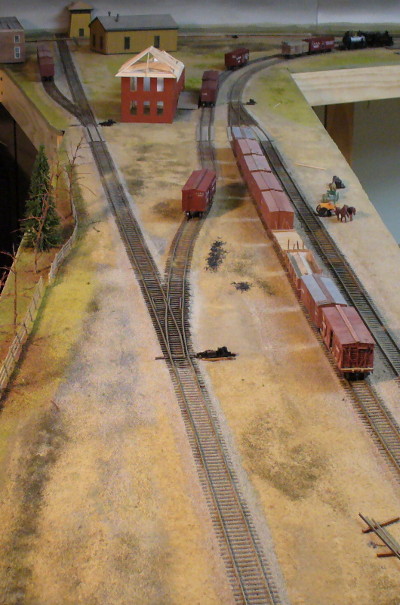
The southern yard is larger, with two tracks in back devoted to Erie, Pennsy, DL&W, B&O, and miscellaneous railroads that might send cars to Auburn. The three tracks in front hold cars of the Lehigh Valley and affiliated railroads such as the Southern Central RR and the Geneva, Ithaca and Sayre RR.

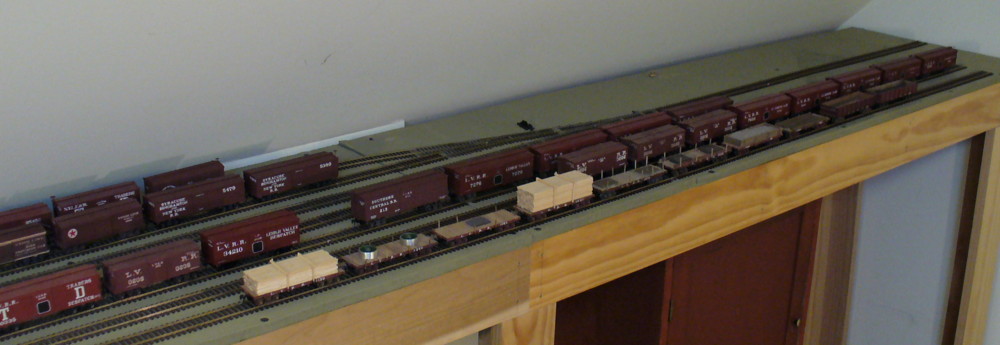
5. Making Up Trains
An operator has a stack of waybills with jobs to do, but no railcar numbers. His or her job is to examine each waybill, find an appropriate car, and write the car's number on the waybill. They will make up the train from these cars. For example, a train from the south end of the layout includes cars with deliveries from sources on railroads that interchange with the Lehigh Valley south of the area represented by my layout, namely the PRR, Erie, B&O, and DL&W. This train will also include LV empties to be dropped off at on-layout destinations for shipments off the layout.
Because I am modeling such a limited extent of the Southern Central (LV), I don't intend to have car movements from one industry on the layout to another. That seems unrealistic.
I can control the frequency of car movements in and out of specific industries by the number of rows in the spreadsheet. I can always repeat rows if I want a proportionately higher number of movements between particular businesses. For instance, a heavy industry might have a contract to deliver coal frequently from a single supplier.
6. Is this a New Idea?
Although I created my own implementation several years ago with my own spreadsheet and facsimile waybills, I cannot take credit for commodity-driven car movements. Magazines first published articles describing this approach a number of years ago, decades I think. Generating waybills that mimic actual ones was my own idea, or at least I don't remember seeing anybody doing this until a couple of years ago, when an article appeared in RMC. They look much more complex than mine largely because waybills convey a lot more information today.
You might be interested in a new computer program that Craig Bisgeier has available to do pretty much what I describe here, judging from the description on his website. It looks to have been developed for much larger layouts than mine and the user can use a database of shippers rather than entering them by hand. One thing Craig and I have in common: when we are finished with a waybill, it goes in the trash.